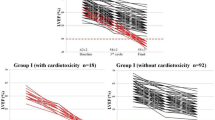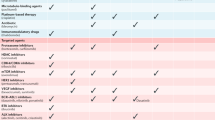Abstract
High-dose cyclophosphamide (HD-CTX) is largely employed in high-dose chemotherapy (HD-CHT) protocols. HD-CTX dose-limiting toxicity expresses itself as cardiac toxicity which is fatal in a minority of patients. The pathophysiology of HD-CTX-associated cardiotoxicity is still poorly understood. Autopsy studies in patients who died from acute HD-CTX-induced cardiac toxicity revealed hemorrhagic myocardial cell death and interstitial edema. Recently troponins, in particular troponin I (cTnI), have been found to represent a uniquely sensitive and specific marker of myocyte membrane integrity and therefore to increase in response to minimal myocardial cell damage in different settings, including doxorubicin-induced cardiotoxicity. We performed a multiparametric cardiologic monitoring in 16 consecutive breast cancer patients undergoing HD-CTX by means of serial ECG registrations and cardiac enzymes (CPK, CPK-MB and cTnI) determinations plus echocardiography in order to clarify acute cardiac events following HD-CTX administration. Neither overt cardiac toxicity nor cardiac enzymes elevation were recorded. Serial ECGs revealed in six cases little and reversible reduction of QRS voltage and/or ST abnormalities. Echo monitoring showed in four cases mild and transient increase of LV diastolic/systolic diameter/volume without decrease of FS% or EF% below normal values: in two of them abnormalities of diastolic function (E/A mitral doppler ratio) were also recorded. We conclude that our protocol of HD-CTX administration does not cause myocardial cell damage as analyzed by serum cTnI levels, thus suggesting that myocyte membrane injury may not be the first direct mechanism of HD-CTX cardiotoxicity. ECG (ie QRS voltages) and Echo (ie E/A ratio) monitoring leads us to hypothesize that slight interstitial edema with reduction of LV diastolic compliance may be initial signs of cardiac dysfunction in this clinical setting. Bone Marrow Transplantation(2001) 28, 277–282.
This is a preview of subscription content, access via your institution
Access options
Subscribe to this journal
Receive 12 print issues and online access
$259.00 per year
only $21.58 per issue
Buy this article
- Purchase on Springer Link
- Instant access to full article PDF
Prices may be subject to local taxes which are calculated during checkout

Similar content being viewed by others
References
Lee CK, Harman GS, Hohl RJ et al. Fatal cyclophosphamide cardiomyopathy: its clinical course and treatment Bone Marrow Transplant 1996 18: 573–577
Ayash LJ, Wright JE, Tretyakov O et al. Cyclophosphamide pharmacokinetics: correlation with cardiac toxicity and tumor response J Clin Oncol 1992 10: 995–1000
Braverman AC, Antin JH, Plappert MT et al. Cyclophosphamide cardiotoxicity in bone marrow transplantation: a prospective evaluation of new dosing regimens J Clin Oncol 1991 9: 1215–1223
Gottdiener JS, Appelbaum FR, Ferrans VJ et al. Cardiotoxicity associated with high-dose cyclophosphamide therapy Arch Intern Med 1981 141: 758–763
Chapelle JP . Cardiac troponin I and troponin T: recent players in the field of myocardial markers Clin Chem Lab Med 1999 37: 11–20
Stubbs P . The cardiac troponins: uses in routine clinical practice. Experiences from GUSTO and other clinical trials Eur Heart J 1998 19: (Suppl. N) N59–63
Stromme JH, Johansen O, Brekke M et al. Markers of myocardial injury in blood following PTCA: a comparison of CKMB, cardiospecific troponin T and troponin I Scand J Clin Lab Invest 1998 58: 693–699
La Vecchia L, Mezzena G, Ometto R et al. Detectable serum troponin I in patients with heart failure of non myocardial ischemic origin Am J Cardiol 1997 80: 482–485
Lauer B, Niederau C, Kuhl U et al. Cardiac troponin T in patients with clinically suspected myocarditis J Am Coll Cardiol 1997 30: 1354–1359
Gianni AM, Siena S, Bregni M et al. Efficacy, toxicity and applicability of high-dose sequential chemotherapy as adjuvant treatment in operable breast cancer with 10 or more axillary nodes involved – five-year results J Clin Oncol 1997 15: 2312–2321
Gianni AM, Bregni M, Siena S et al. Recombinant human granulocyte–macrophage colony stimulating factor reduces hematologic toxicity and widens clinical applicability of high-dose cyclophosphamide treatment in breast cancer and non Hodgkin's lymphoma J Clin Oncol 1990 8: 768–778
Antman EM, Tanasijevic MJ, Thompson B et al. Cardiac-specific troponin I levels to predict the risk of mortality in patients with acute coronary syndromes New Engl J Med 1996 335: 1342–1349
Bregni M, Siena S, Di Nicola M et al. Dose–response effect of cyclophosphamide in locally advanced/metastatic breast cancer Bone Marrow Transplant 1998 21: (Suppl. 1) S59 (abstr. 210)
Siena S, Bregni M, Brando B et al. Circulation of CD34+ hematopoietic stem cells in the peripheral blood of high-dose cyclophosphamide treated patients: enhancement by intravenous recombinant human granulocyte–macrophage colony stimulating factor Blood 1989 74: 1905–1914
Zujewski J, Nelson A, Abrams J . Much ado about not enough data: high-dose chemotherapy with autologous stem cell rescue for breast cancer J Natl Cancer Inst 1998 90: 200–209
Neymark N, Rosti G, Ferrante P et al. Peripheral blood stem cell transplantation for breast carcinoma in Europe 1998. A joint EBMT and EORTC report Proc Am Soc Clin Oncol 1999 18: 64 (Abstr. 238)
Steinherz LJ, Steinherz PG . Cyclophosphamide cardiotoxicity Cancer Bull 1985 37: 231–236
Klein JL, Maroto Rey P, Dansey RD et al. Cardiac sequelae of doxorubicin and paclitaxel as induction chemotherapy prior to high-dose chemotherapy and peripheral blood progenitor cell transplantation in women with high-risk primary or metastatic breast cancer Bone Marrow Transplant 2000 25: 1047–1052
Brockstein BE, Smiley C, Al-Sadir J et al. Cardiac and pulmonary toxicity in patients undergoing high-dose chemotherapy for lymphoma and breast cancer: prognostic factors Bone Marrow Transplant 2000 25: 885–894
Hughes-Davies L, Sacks D, Rescigno J et al. Serum cardiac troponin T levels during treatment of early-stage breast cancer J Clin Oncol 1995 13: 2582–2584
Raderer M, Kornek G, Weinlander G et al. Serum troponin T levels in adults undergoing anthracycline therapy J Natl Cancer Inst 1997 89: 171
Lipshultz SE, Rifai N, Sallan SE et al. Predictive value of cardiac troponin T in paediatric patients at risk for myocardial injury Circulation 1997 96: 2641–2648
Herman HE, Zhang J, Lipshultz SE et al. Correlation between serum levels of cardiac troponin-T and the severity of the chronic cardiomyopathy induced by doxorubicin J Clin Oncol 1999 17: 2237–2244
Sparano JA, Wolff AC, Brown D . Troponins for predicting cardiotoxicity from cancer therapy Lancet 2000 356: 1947–1948
Auner HW, Tinchon C, Quehenberger F et al. Troponins in prediction of cardiotoxic effects Lancet 2001 357: 808
Missov E, Calzolari C, Davy JM et al. Cardiac troponin I in patients with hematologic malignancies Coron Artery Dis 1997 8: 537–541
Cardinale D, Sandri MT, Martinoni A et al. Left ventricular disfunction predicted by early troponin I release after high-dose chemotherapy J Am Coll Cardiol 2000 36: 517–522
Busse D, Busch WF, Bohnenstengel F et al. Dose escalation of cyclophosphamide in patients with breast cancer: consequences for pharmacokinetics and metabolism J Clin Oncol 1997 15: 1885–1896
Ren S, Kalhorn TF, McDonald GB et al. Pharmacokinetics of cyclophosphamide and its metabolites in bone marrow transplantation patients Clin Pharmacol Ther 1998 64: 289–301
Chen TL, Kennedy MJ, Anderson LW et al. Non linearpharmacokinetics of cyclophosphamide and 4-hydroxycyclophosphamide/aldophosphamide in patients with metastatic breast cancer receiving high-dose chemotherapy followed by autologous bone marrow transplantation Drug Metab Dis 1997 25: 544–551
Slattery JT, Kalhorn MJ, McDonald GB et al. Conditioning regimen-dependent disposition of cyclophosphamide and hydroxycyclophosphamide in human marrow transplantation patients J Clin Oncol 1996 14: 1484–1494
Gilbert CJ, Petros WP, Vredenburgh J et al. Pharmacokinetic interaction between ondansetron and cyclophosphamide during high-dose chemotherapy for breast cancer Cancer Chemother Pharmacol 1998 42: 497–503
Huitema AD, Mathot RA, Tibben MM et al. Population pharmacokinetics of thioTEPA and its active metabolite TEPA in patients undergoing high-dose chemotherapy Br J Clin Pharmacol 2001 51: 61–70
Huitema AD, Kerbusch T, Tibben MM et al. Reduction of cyclophosphamide bioactivation by thioTEPA: critical sequence-dependency in high-dose chemotherapy regimens Cancer Chemother Pharmacol 2000 46: 119–127
Voelcker G, Wagner T, Wientzek C et al. Pharmacokinetics of ‘activated’ cyclophosphamide and therapeutic efficacies Cancer 1984 54: 1179–1186
Gianni AM, Bregni M, Siena S et al. High-dose chemotherapy and autologous bone marrow transplantation compared with MACOP-B in aggressive B-cell lymphoma New Engl J Med 1997 336: 1290–1297
Acknowledgements
We thank the nursing staff of the Division of Medical Oncology for their dedicated patient care and Dr G Rosti for helpful discussion and criticism. We are also grateful to the doctors of the Division of Medical Oncology and the laboratory staff of the San Bortolo Hospital.
Author information
Authors and Affiliations
Rights and permissions
About this article
Cite this article
Morandi, P., Ruffini, P., Benvenuto, G. et al. Serum cardiac troponin I levels and ECG/Echo monitoring in breast cancer patients undergoing high-dose (7 g/m2) cyclophosphamide. Bone Marrow Transplant 28, 277–282 (2001). https://doi.org/10.1038/sj.bmt.1703132
Received:
Accepted:
Published:
Issue Date:
DOI: https://doi.org/10.1038/sj.bmt.1703132
Keywords
This article is cited by
-
Cyclophosphamide arrhythmogenicitytesting using human-induced pluripotent stem cell-derived cardiomyocytes
Scientific Reports (2021)
-
Transplantation for chemotherapy-induced cardiomyopathy—case series and review of current practice
Indian Journal of Thoracic and Cardiovascular Surgery (2020)
-
Bisoprolol and linagliptin ameliorated electrical and mechanical isometric myocardial contractions in doxorubicin-induced cardiomyopathy in rats
Pharmacological Reports (2020)
-
The clinical features of fatal cyclophosphamide-induced cardiotoxicity in a conditioning regimen for allogeneic hematopoietic stem cell transplantation (allo-HSCT)
Annals of Hematology (2016)
-
Chemotherapy-induced cardiomyopathy
Heart Failure Reviews (2015)



